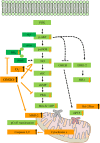Effect of hypercholesterolaemia on myocardial function, ischaemia-reperfusion injury and cardioprotection by preconditioning, postconditioning and remote conditioning
- PMID: 28060997
- PMCID: PMC5446572
- DOI: 10.1111/bph.13704
Effect of hypercholesterolaemia on myocardial function, ischaemia-reperfusion injury and cardioprotection by preconditioning, postconditioning and remote conditioning
Abstract
Hypercholesterolaemia is considered to be a principle risk factor for cardiovascular disease, having direct negative effects on the myocardium itself, in addition to the development of atherosclerosis. Since hypercholesterolaemia affects the global cardiac gene expression profile, among many other factors, it results in increased myocardial oxidative stress, mitochondrial dysfunction and inflammation triggered apoptosis, all of which may account for myocardial dysfunction and increased susceptibility of the myocardium to infarction. In addition, numerous experimental and clinical studies have revealed that hyperlcholesterolaemia may interfere with the cardioprotective potential of conditioning mechanisms. Although not fully elucidated, the underlying mechanisms for the lost cardioprotection in hypercholesterolaemic animals have been reported to involve dysregulation of the endothelial NOS-cGMP, reperfusion injury salvage kinase, peroxynitrite-MMP2 signalling pathways, modulation of ATP-sensitive potassium channels and apoptotic pathways. In this review article, we summarize the current knowledge on the effect of hypercholesterolaemia on the non-ischaemic and ischaemic heart as well as on the cardioprotection induced by drugs or ischaemic preconditioning, postconditioning and remote conditioning. Future perspectives concerning the mechanisms and the design of preclinical and clinical trials are highlighted.
Linked articles: This article is part of a themed section on Redox Biology and Oxidative Stress in Health and Disease. To view the other articles in this section visit http://onlinelibrary.wiley.com/doi/10.1111/bph.v174.12/issuetoc.
© 2017 The British Pharmacological Society.
Figures

Similar articles
-
Myocardial ischaemia reperfusion injury and cardioprotection in the presence of sensory neuropathy: Therapeutic options.Br J Pharmacol. 2020 Dec;177(23):5336-5356. doi: 10.1111/bph.15021. Epub 2020 Mar 21. Br J Pharmacol. 2020. PMID: 32059259 Free PMC article. Review.
-
Interaction of cardiovascular risk factors with myocardial ischemia/reperfusion injury, preconditioning, and postconditioning.Pharmacol Rev. 2007 Dec;59(4):418-58. doi: 10.1124/pr.107.06002. Epub 2007 Nov 29. Pharmacol Rev. 2007. PMID: 18048761 Review.
-
Effect of hyperglycaemia and diabetes on acute myocardial ischaemia-reperfusion injury and cardioprotection by ischaemic conditioning protocols.Br J Pharmacol. 2020 Dec;177(23):5312-5335. doi: 10.1111/bph.14993. Epub 2020 Mar 9. Br J Pharmacol. 2020. PMID: 31985828 Free PMC article. Review.
-
Hyperlipidaemia and cardioprotection: Animal models for translational studies.Br J Pharmacol. 2020 Dec;177(23):5287-5311. doi: 10.1111/bph.14931. Epub 2020 Jan 17. Br J Pharmacol. 2020. PMID: 31769007 Free PMC article. Review.
-
Interaction of Cardiovascular Nonmodifiable Risk Factors, Comorbidities and Comedications With Ischemia/Reperfusion Injury and Cardioprotection by Pharmacological Treatments and Ischemic Conditioning.Pharmacol Rev. 2023 Jan;75(1):159-216. doi: 10.1124/pharmrev.121.000348. Epub 2022 Dec 8. Pharmacol Rev. 2023. PMID: 36753049 Free PMC article. Review.
Cited by
-
Bladder Hyperactivity Induced by Oxidative Stress and Bladder Ischemia: A Review of Treatment Strategies with Antioxidants.Int J Mol Sci. 2021 Jun 2;22(11):6014. doi: 10.3390/ijms22116014. Int J Mol Sci. 2021. PMID: 34199527 Free PMC article. Review.
-
The role of mitochondrial reactive oxygen species, NO and H2 S in ischaemia/reperfusion injury and cardioprotection.J Cell Mol Med. 2020 Jun;24(12):6510-6522. doi: 10.1111/jcmm.15279. Epub 2020 May 8. J Cell Mol Med. 2020. PMID: 32383522 Free PMC article. Review.
-
Non-Invasive whole-body detection of complement activation using radionuclide imaging in a mouse model of myocardial ischaemia-reperfusion injury.Sci Rep. 2017 Nov 23;7(1):16090. doi: 10.1038/s41598-017-16387-1. Sci Rep. 2017. PMID: 29170426 Free PMC article.
-
Alleviating Effects of Ovatodiolide and Antcin K Supplements on High-Fat Diet-Induced Cardiovascular Dysfunction in ApoE-Knockout Mice by Attenuating Oxidative Stress.Nutrients. 2023 Sep 20;15(18):4074. doi: 10.3390/nu15184074. Nutrients. 2023. PMID: 37764856 Free PMC article.
-
Potential Role of Tocotrienols on Non-Communicable Diseases: A Review of Current Evidence.Nutrients. 2020 Jan 19;12(1):259. doi: 10.3390/nu12010259. Nutrients. 2020. PMID: 31963885 Free PMC article. Review.
References
Publication types
MeSH terms
LinkOut - more resources
Full Text Sources
Other Literature Sources
Medical
Miscellaneous

